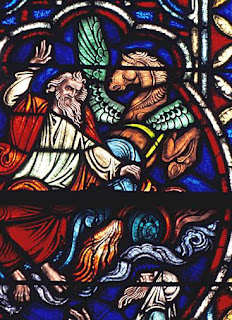Before I post part two of my assessment of the rejection of the eternal generation of the Son of God by Driscoll & Breshears in
Doctrine: What Christians Should Believe let me post this item from the archives. This may be helpful in the light of the discussion thread on the previous post...
One of the heresies to trouble the early church, and not only the early church, for it has to a lesser or greater extent continued to present itself as a plausible alternative to Trinitarian orthodoxy, was the heresy of modalism.
This heresy posits no distinction between the persons in the Godhead, refusing to speak of three eternally distinct persons in communion. Rather, what we have is a God who is one in essence and person. The modalist understanding is that although God manifests himself as Father, Son and Spirit these are not three distinct, co-equal and co-eternal persons. The appearance of the three persons is only the successive appearance of three modes by which God reveals himself.
The modalist interpretation of the relationship between the being of God and the titles Father, Son and Spirit, is, at the very least, an exegetical failure. It fails to fully account for all the biblical material, it fails it synthesize that data, and it fails assign the proper meaning to the texts at hand. This deficiency was pointed out by the fourth century father Hilary of Poitiers:
For there have risen many who have given to the plain words of Holy Writ some arbitrary interpretation of their own, instead of its true and only sense, and this in defiance of the clear meaning of words. Heresy lies in the sense assigned, not in the word written; the guilt is that of the expositor, not of the text.
On the Trinity, Book 2, section 3
Since, therefore, they cannot make any change in the facts recorded, they bring novel principles and theories of man’s device to bear upon them. Sabellius, for instance, makes the Son an extension of the Father, and the faith in this regard a matter of words rather than of reality, for he makes one and the same Person, Son to Himself and also Father.
Book 2, section 4
In contrast to that a minimal framework for Trinitarian belief would include the following affirmations:
A. There is only one God
B. There are three distinct persons in the Godhead: the Father, the Son and the Spirit
C. Each of these persons is fully God
What should we consider to be the necessary and sufficient evidence to affirm these points?
1. That it can be shown from Scripture that there are distinctions between the persons, distinctions that show that the threeness of persons and oneness of essence are equally ultimate.
2. That it can be shown from Scripture that the titles, works, and worship that belong properly to the one true and living God, are given to the Father, Son and Holy Spirit.
3. That we read and interpret the biblical data conscious that the lens through which we view the Trinity is that of the economy of salvation (the Father sending the Son, the Son humbling himself and becoming incarnate as the last Adam, the Spirit of God coming to glorify Christ and apply his saving work). This lens is itself part of the biblical data.
On point (1) this evidence would include texts that speak of :
1.1. The sending of one divine person by another (e.g. Exodus 23:20-21; Isaiah 48:16; Malachi 3:1-2; John 15:26)
1.2. The work of one divine person in relation to another divine person (e.g. Isaiah 61:1-2; Hosea 1:7)
1.3. The ascription of divine titles and works to more than one person within the same literary unit (e.g. Genesis 19:24; Zechariah 2:9-12; Psalm 110:1; Joshua 24:2-12 cf. Judges 2:1-4; Malachi 3:1-2; John 1:1, 18; Galatians 1:3; Revelation 1:8, 17; 22:12-13)
1.4. Reference being made to more than one divine person within the same literary unit, to whom elsewhere in Scripture divine titles and works have been ascribed (e.g. Isaiah 48:16; 63:9-12)
1.5. One divine person speaking of another divine person (e.g. Exodus 23:20-22; Isaiah 48:16; Isaiah 52:13, cf. Isaiah 6:1, 57:15, Hosea 1:6-7; Mark 1:11; Mark 9:7; John 15:26)
1.6. One divine person speaking to another divine person (e.g. Genesis 1:26-27; Psalm 45:6-7; Psalm 110:1; John 17:5)
Some of the texts and categories above are obviously interconnected. Exodus 23:20-21 fits into 1.1./1.3./ and 1.5. The selection of passages above is only representative. As there is a superabundance of NT passages I have chosen more from the OT.
By the way, modalists tie themselves up in knots when the try to explain away the obvious. Jesus prays to his Father. Is this not clear evidence that they are two distinct persons? The modalist would have to say that Jesus' human nature is praying to his own divine nature. But persons speak to each other, not natures.


















